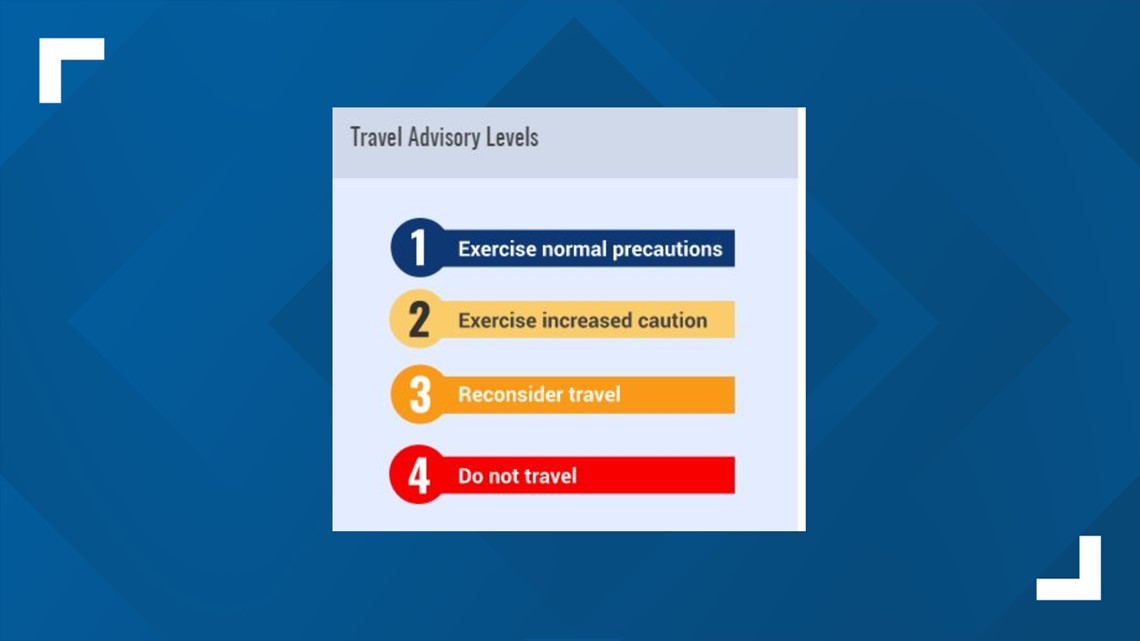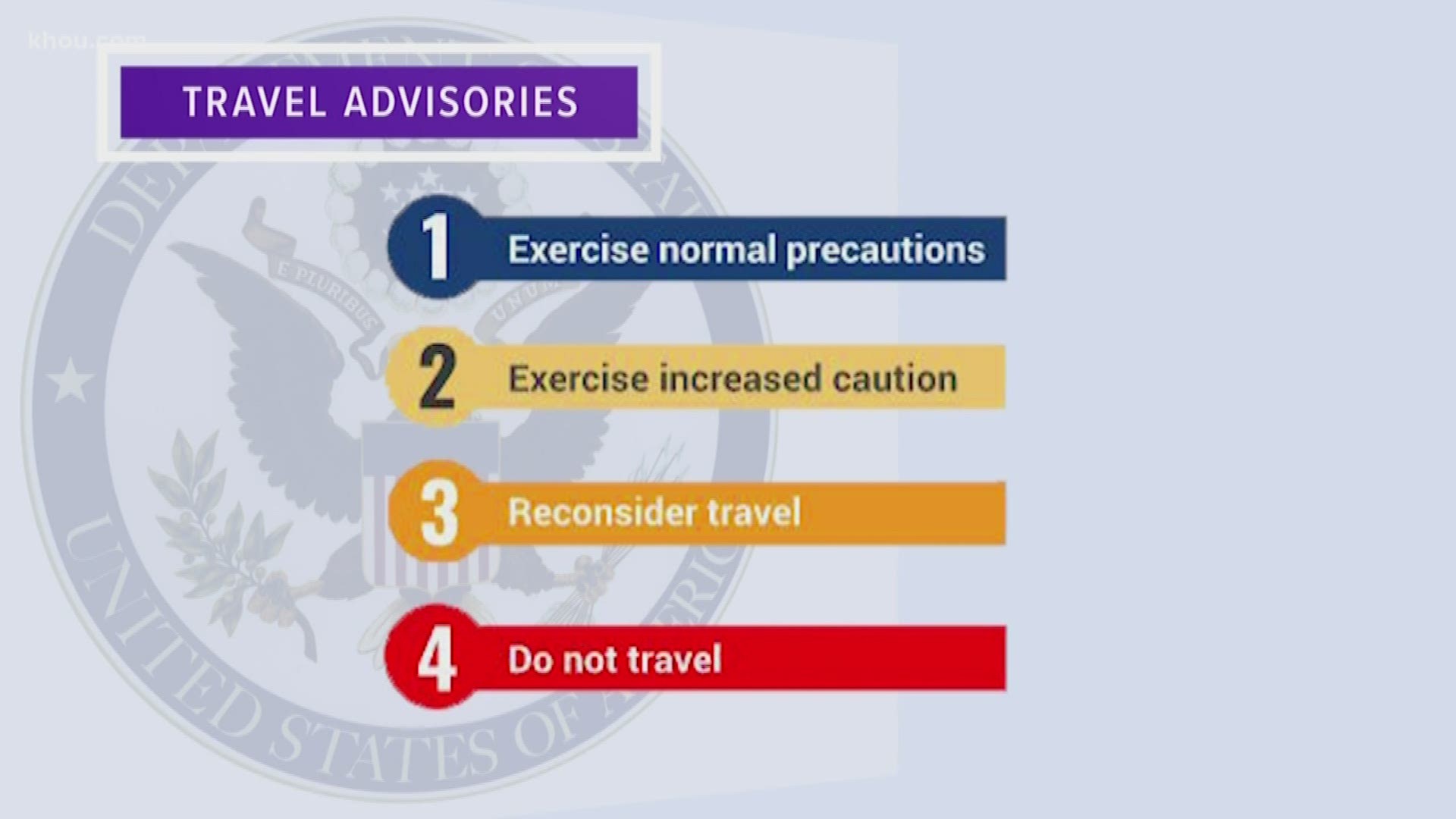HOUSTON — A 13-year old American boy is dead and two U.S. citizens were wounded after an attack in Mexico's Ciudad Mier in Tamaulipas state, which is just across the border from Roma, Texas in the Rio Grande Valley.
We're waiting on the U.S. State Department to issue more details about the Saturday night deadly shooting -- but we do know the teen was in a vehicle that had Oklahoma license plates.
The violence happened less than three weeks after the U.S. State Department renewed the travel advisory for Mexico on December 17, 2019.
The U.S. State Department is asking Americans to not travel to Tamaulipas state because of violent crime like gun battles, murder, armed robbery, carjackings, kidnapping, forced disappearances, extortion and sexual assault. Those crimes are especially common in the northern border and in Ciudad Victoria, which is near Ciudad Mier.
The federal government established four levels of travel advisories in January 2018. Under this system, every country has a travel advisory. But, levels of advice vary for specific locations or areas within a country.


The latest advisory for travel to Mexico is: Level 2. Americans are asked to exercise increased caution in Mexico due to crime and kidnapping. some areas have increased risk.
Do Not Travel To:
- Colima state due to crime.
- Guerrero state due to crime.
- Michoacán state due to crime.
- Sinaloa state due to crime.
- Tamaulipas state due to crime and kidnapping.
Reconsider Travel To:
- Chihuahua state due to crime.
- Coahuila state due to crime.
- Durango state due to crime.
- Jalisco state due to crime.
- Mexico state due to crime.
- Morelos state due to crime.
- Nayarit state due to crime.
- Nuevo Leon state due to crime.
- San Luis Potosi state due to crime.
- Sonora state due to crime.
- Zacatecas state due to crime.
WHAT ABOUT TRAVEL TO POPULAR TOURIST SPOTS?
Baja California state – Level 2: Exercise Increased Caution
Exercise increased caution due to crime.
Criminal activity and violence occur throughout the state. Particularly notable is the number of homicides in non-tourist areas of Tijuana. Most homicides appeared to be targeted; however, criminal organization assassinations and turf battles can result in bystanders being injured or killed.
Due to poor cellular service and hazardous road conditions, U.S. government employees may only travel on Highway 2D between Mexicali and Tijuana during daylight hours.
There are no additional restrictions on travel for U.S. government employees in Baja California, which includes tourist areas in: Ensenada, Rosarito, and Tijuana.
Baja California Sur state – Level 2: Exercise Increased Caution
Exercise increased caution due to crime.
Criminal activity and violence occur throughout the state, including in areas frequented by U.S. citizens. Bystanders have been injured or killed in shooting incidents related to criminal organization turf battles. Petty crime occurs frequently in tourist areas.
There are no restrictions on travel for U.S. government employees in Baja California Sur, which includes tourist areas in: Cabo San Lucas, San Jose del Cabo, and La Paz.
Campeche state – Level 2: Exercise Increased Caution
Exercise increased caution due to crime. Police presence and emergency response are extremely limited outside of the state capital.
There are no restrictions on travel for U.S. government employees in Campeche state, which includes tourist areas in: Campeche City, Calakmul, Edzna, and Palizada.
Guerrero state – Level 4: Do Not Travel
Do not travel due to crime.
Crime and violence are widespread. Armed groups operate independently of the government in many areas of Guerrero. Members of these groups frequently maintain roadblocks and may use violence towards travelers.
U.S. government employees may not travel to the entire state of Guerrero, including Acapulco, Zihuatanejo, Ixtapa, and Taxco.
Jalisco state – Level 3: Reconsider Travel
Reconsider travel due to crime.
Violent crime and gang activity are common in parts of Jalisco state. In metropolitan Guadalajara, battles for territory control between criminal groups take place in areas frequented by U.S. citizens. Shooting incidents between criminal groups have injured or killed innocent bystanders.
U.S. government employees may not travel to:
- Within 20 km (12 miles) of the Jalisco/Michoacán border, south of Route 120
- Highway 80 south of Cocula
- Highway 544 from Mascota to San Sebastian del Oeste
There are no restrictions on travel for U.S government employees to: Guadalajara Metropolitan Area, Riviera Nayarit (including Puerto Vallarta), Chapala, and Ajijic.
Mexico City – Level 2: Exercise Increased Caution
Exercise increased caution due to crime.
Both violent and non-violent crimes occur throughout Mexico City. Use additional caution outside of the frequented tourist areas where police and security patrol more routinely, particularly at night. Petty crime occurs frequently in both tourist areas and non-tourist areas.
There are no restrictions on travel for U.S. government employees.
Nayarit state – Level 3: Reconsider Travel
Reconsider travel due to crime.
Violent crime and gang activity are common in parts of Nayarit state. U.S. government employees may not travel to:
- Tepic
- San Blas
There are no restrictions on travel for U.S government employees to: Riviera Nayarit (including Nuevo Vallarta, Punta Mita, and Bahia de Banderas), and Santa Maria del Oro.
Oaxaca state – Level 2: Exercise Increased Caution
Exercise increased caution due to crime.
U.S. government employees may not travel to:
- Isthmus region of Oaxaca, defined by Highway 185D to the west, Highway 190 to the north, and the Oaxaca/Chiapas border to the east. This includes the towns of Juchitan de Zaragoza, Salina Cruz, and San Blas Atempa.
- Highway 200 northwest of Pinotepa.
There are no restrictions on travel for U.S. government employees to other parts of Oaxaca state, which include tourist areas in: Oaxaca City, Monte Alban, Puerto Escondido, and Huatulco.
Quintana Roo state – Level 2: Exercise Increased Caution
Exercise increased caution due to crime.
Criminal activity and violence, including homicide, occur throughout the state. Most homicides appear to be targeted; however, criminal organization assassinations and turf battles between criminal groups have resulted in violent crime in areas frequented by U.S. citizens. Bystanders have been injured or killed in shooting incidents.
There are no restrictions on travel for U.S. government employees in Quintana Roo state, which include tourist areas in: Cancun, Cozumel, Isla Mujeres, Playa del Carmen, Tulum, and the Riviera Maya.
Yucatan state – Level 2: Exercise Increased Caution
Exercise increased caution due to crime. Police presence and emergency response are extremely limited outside of the state capital.
There are no restrictions on travel for U.S. government employees in Yucatan state, which includes tourist areas in: Chichen Itza, Merida, Uxmal, and Valladolid.
ALSO POPULAR ON KHOU.COM

